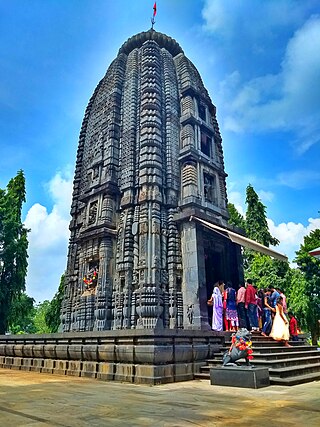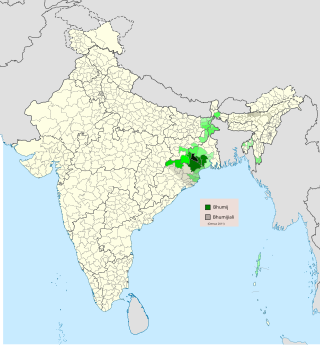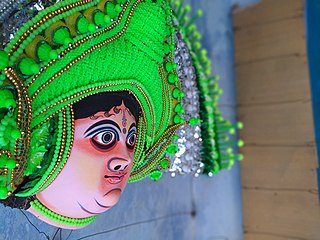
Mayurbhanj district is one of the 30 districts in the Odisha state of eastern India. It holds the distinction of being the largest district in Odisha by area. The district's headquarters is located in Baripada, with other major towns including Rairangpur, Karanjia, and Bahalda. As of 2011, Mayurbhanj ranks as the third-most populous district in Odisha, following Ganjam and Cuttack.

Seraikela-Kharsawan district or Saraikella and Kharaswan district is one of the twenty-four districts of Jharkhand state in eastern India. Seraikela town is the district headquarters of Saraikela Kharsawan district. The district is well known for Seraikela Chhau, one of the three distinctive styles of the chhau dance. This district was carved out from West Singhbhum district in 2001. The district was formed from the princely states of Seraikela and Kharaswan, after the independence of India.

Sharon Lowen is an American Odissi dancer, trained since 1975 by Guru Kelucharan Mohapatra. She has performed and choreographed for film and television and presented hundreds of concerts throughout India, North America, Asia, Africa, the United Kingdom. and the Middle East. Sharon came to India in 1973 after earning degrees in Humanities, Fine Arts, Asian Studies and Dance from the University of Michigan as a Fulbright Scholar to study Manipuri and later Chhau and Odissi.
Saraikela is the district headquarters and a nagar panchayat in the Seraikela Sadar subdivision of the Seraikela Kharsawan district in the Indian state of Jharkhand. It was formerly the capital of Saraikela State, a princely state. The town is a road junction, an agricultural trade centre and upcoming industrial centre. It is situated between Jamshedpur and Chaibasa.
Odisha is one of the 28 states of India, located on the eastern coast. It is surrounded by the states of West Bengal to the northeast, Jharkhand to the north, Chhattisgarh to the west and northwest, and Andhra Pradesh to the south and southwest. Odia is the official and most widely spoken language, spoken by 33.2 million according to the 2001 Census. The modern state of Odisha was established on 1 April 1936, as a province in British India, and consisted predominantly of Odia-speaking regions. April 1 is celebrated as Odisha Day.

Bhumij is an Austroasiatic language belonging to the Munda subfamily, related to Ho, Mundari, and Santali, primarily spoken by Bhumij peoples in the Indian states Jharkhand, Odisha and West Bengal. As per the 2011 census, only 27,506 people out of 9,11,349 Bhumij people spoke Bhumij as their mother tongue, as most Bhumijas have shifted to one of the regional dominant languages. Thus the language is considered an extremely endangered language.
Manbhumi or Manbhumi Bengali is the local Bengali dialect spoken in the district of Purulia, and adjacent area of other districts of West Bengal and Jharkhand, previously Manbhum, in Eastern India. It is one of the Bengali dialects, having some influences of neighbouring dialects of Hindi and Odia in it.
Kedar Nath Sahoo was an Indian classical dancer, known as one of the leading exponents of the Seraikella tradition of Chhau dance. He served as the founder director of the Government Chhau Dance Centre of the Government of Jharkhand where he served from 1974 to 1988. During the early stages of his career, he performed with the troupe led by Kumar Bijay Pratap Singh Deo, but later led his own group of dancers for performance in many places in India and abroad including Eastern Europe, South America and Southeast Asia. His students included many notable dancers like Sharon Lowen, Gopal Prasad Dubey and Shashadhar Acharya. He was a recipient of the 1981 Sangeet Natak Akademi Award and the Government of India awarded him the fourth highest civilian honour of the Padma Shri, in 2005, for his contributions to arts. Towards the latter part of his life, his health failed and he died on 8 October 2008 at his home in Kansari tola, aged 88. He was married, and had five sons and four daughters.

Mask or Mukhosh of West Bengal, as it is known for has a mysterious history. Mostly it uses for the Mask Dance, the folk dance of West Bengal. The wearing of these masks is connected with early types of folklore and religion. There are various type of masks made up of clay, wood, sponge wood or shola, pith, paper, metal etc. Generally, half of these masks are made up of clay, pith and paper and wooden masks are very rare. Some of these masks come from the Tribal of West Bengal. Geographically, West Bengal comes well within this mask using culture zone. Masks in West Bengal is mostly used in folk dance. UNESCO selected The Rural Craft Hub of Bengal to showcase their artwork in Paris in 2015.

The Indian state, West Bengal has a rich cultural heritage. Due to the reign of many different rulers in the past, arts and crafts in West Bengal underwent many changes giving an artistic diversity today in the forms of traditional handicrafts, terracotta, painting and carving, dances and music.

The Chhau mask is a traditional cultural heritage of Purulia in the Indian state of West Bengal. The Chhau mask of Purulia is registered on the List of Geographical Indications. As the basic difference of Purulia Chhau the mask is unique and traditional.

Chandil Dam was built across the Subarnarekha, in Bihar, as a part of the Subarnarekha Multipurpose Project.
Kharsawan block is a CD block that forms an administrative division in the Seraikela Sadar subdivision of Seraikela Kharsawan district, in the Indian state of Jharkhand.
Ichagarh block is a CD block that forms an administrative division in the Chandil subdivision of Seraikela Kharsawan district, in the Indian state of Jharkhand.
Kukru block is a CD block that forms an administrative division in the Chandil subdivision of Seraikela Kharsawan district, in the Indian state of Jharkhand.
Nimdih block is a CD block that forms an administrative division in the Chandil subdivision of Seraikela Kharsawan district, in the Indian state of Jharkhand.
Adityapur block is a CD block that forms an administrative division in the Seraikela Sadar subdivision of Seraikela Kharsawan district, in the Indian state of Jharkhand.

Seraikela block is a CD block that forms an administrative division in the Seraikela Sadar subdivision of Seraikela Kharsawan district, in the Indian state of Jharkhand.

Gobindpur block is a CD block that forms an administrative division in the Seraikela Sadar subdivision of Seraikela Kharsawan district, in the Indian state of Jharkhand.































